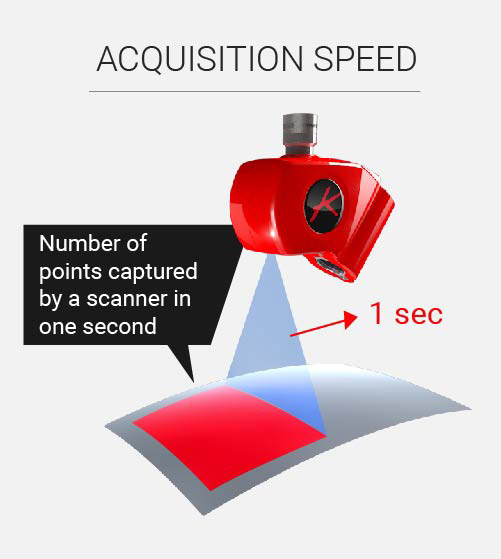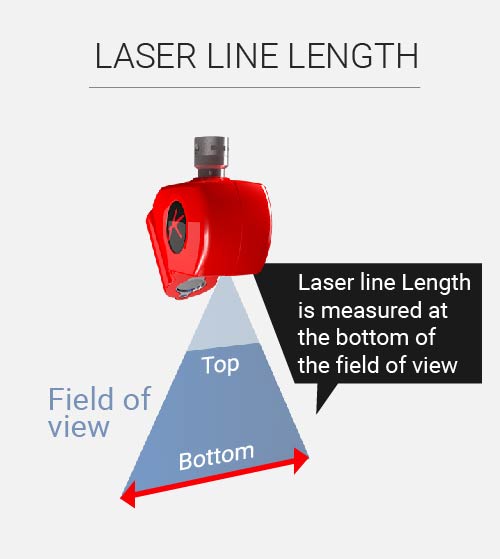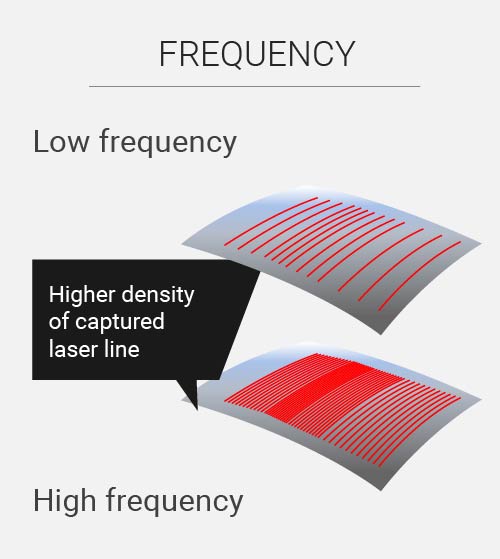Scanning speed is often the first selection criterion when buying a 3D laser scanner because it is essential for time-consuming operations such as quality control on serial parts.This is especially the case when parts have large areas to scan, requiring multiple scan passes. So in many cases, working time and productivity are directly linked to scanning speed, but what exactly do we mean when talking about scanning speed?
Acquisition speed
Acquisition speed definition
In most users’ minds, scanning speed is equal to acquisition speed which is the number of points per second captured on the object area. Certainly, that could be true but not always. Acquisition speed is calculated by multiplying two values: frequency (number of laser lines recorded per second) and the number of points on each laser line. Thus, a scanner with 1000 points per line with a frequency of 150Hz delivers an acquisition speed of 150.000 points per second.
Point cloud density and performances
3D scanners currently available on the market offer various speeds, from a few tens of thousands to hundreds of thousands of points per second. A low acquisition speed requires a high number of scan passes to get a maximum point density. On the other hand, a high acquisition speed always provides a high point density. That last solution needs software and hardware with high performances, well adapted for dealing with clouds including many millions of points.

Laser line length
Relationship between laser line length and filed of view
The laser line length varies with the distance from the scanner with respect to the part. The closer the scanner is, the narrower is the laser line (top of scanner field of view); the farther it is, the larger is the laser line (bottom of the scanner field of view). This is due to the creation of the laser line, emitted from a fix point on the scanner and drawing a triangle in the space. Commonly, the value noted by the manufacturer is the larger value, i.e.: the one on the bottom of the scanner field of view.
The laser line can be compared to a paint roller
Let’s look at an example showing the relationship between the laser line length and the speed. Imagine a 500mm x 500mm surface to be painted, it surely would be quicker if a large paint roller was used. The logic is the same with a 3D scanner. With a 50mm laser width, 10 scan passes are necessary to acquire the entire area, but with a 100mm laser line width only 5 are needed, so the latter is in theory twice as fast.

Frequency
„One of the most important indicators to look at“
Frequency, rarely considered in the buying process, is although one of the most important indicators to look at, when talking about 3D scanner speed. As we have said before, frequency is the number of laser lines recorded per second. Comparing two scanners with the same acquisition speed but with different frequencies helps to understand the role of the frequency in relation to the scanning speed.
High frequency for a fluid gesture
For example, scanner A and B, with frequencies of respectively 200Hz and 50Hz, are tested on a measuring arm. Scanner A can be used easily because the hand gesture remains fluid and it moves with a natural speed without gaps on the point cloud. With scanner B, scanning at a natural speed is impossible, gaps between each laser line are immediately visible on the point cloud, hand gestures have to be 4 times slower (because frequency is 4 times lower) to obtain the same result as with scanner A.
But why does scanner B has the same acquisition speed as scanner A? Because scanner B has 4 times more points on each laser line. The acquisition speed of scanner B seems adequate, but when using it, even on robot, CMM or measuring arm, it is really slow.

In conclusion, the speed of a scanner is not a unique data but a set of parameters. If speed is required, choosing the correct parameter is important. Depending on the application, the right speed parameter optimizes your scanning process, for example scanning larger surfaces, acquiring more precise details or moving the scanner faster.
